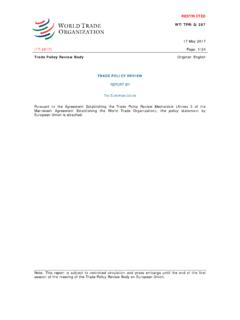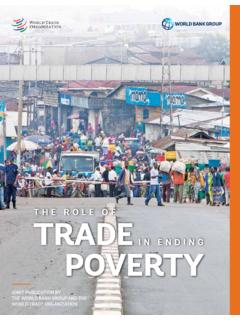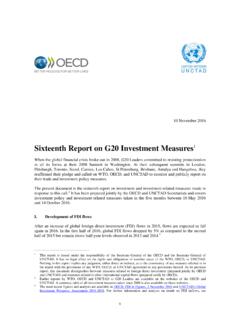Transcription of Can Blockchain revolutionize international trade?
1 Can Blockchain revolutionize international trade? By Emmanuelle Ganne Can Blockchain revolutionize international trade? By Emmanuelle Ganne Disclaimer The opinions expressed in this study are those of the author. They are not intended to represent the positions or opinions of the WTO or its members and are without prejudice to members' rights and obligations under the WTO. Any errors are attributable to the author. World Trade Organization 2018. Reproduction of the material contained in this publication may be made only with the written permission of the WTO Publications Manager. Print ISBN 978-92-870-4760-1. Web ISBN 978-92-870-4761-8. WTO Publications World Trade Organization 154, rue de Lausanne CH-1211 Geneva 2. Switzerland Tel: +41 (0)22 739 51 11. Email: WTO Online Bookshop Report designed by Services Concept. Printed by the World Trade Organization. Photo credits: Cover image: Getty/Photographer is my life.
2 Images page 79: Provenance. Published by the World Trade Organization. Table of contents Acknowledgements v Executive summary vii 1. Introduction 1. 2. Blockchain in a nutshell 3. 1. A brief history 3. 2. Blockchain 101 5. 3. Types of blockchains 8. 4. Smart contracts A smart invention with no smart component 13. 5. Multiple applications but not a solution to everything 14. 3. Can Blockchain revolutionize international trade? 17. 1. Towards paperless trade? 17. 2. A new generation of services? 46. 3. Strengthening intellectual property rights 57. 4. Enhancing government procurement processes 67. 4. A world of and challenges 77. 1. Multifaceted opportunities 77. 2. Success is not a given 90. 5. Conclusion 111. Annex Blockchain for tech fans 113. Glossary 120. Bibliography 128. Abbreviations 142. List of figures and tables 144. iii Acknowledgements My sincere thanks go to my colleague Ms Kenza Le Mentec for her precious guidance.
3 Kenza introduced me to the subject and provided invaluable inputs, in particular for the technical sections describing the technology and the section on trade facilitation. This publication would not have been possible without her support. I am also most grateful to Mr Shashank Rai, Senior Strategic Technology Specialist at UNICC, for his technical insights, advice and guidance, and for having taken the time to exchange views and review the report. His technical inputs were extremely valuable. My thanks also go to the various experts from Accenture, the Danish Customs, Deloitte, the Dutch Customs, Everledger, IBM, Maersk, VCargoCloud and , who took the time to talk to me and share their insights on Blockchain and the various projects on which they have been working. In addition, I wish to thank Enrico Camerinelli, Senior Analyst at Aite Group, Shantanu Godbole of IBM Research, Philippe Heeren, Lawyer at Deloitte Legal, Jonathan Koh, Managing Director at Trade Facilitation Pte Ltd, Lance Thompson, Secretary, UN/CEFACT UNECE, as well as the Hyperledger team, in particular Brian Behlendorf, Executive Director of the Hyperledger project, Ry Jones, Community Architect, and Marta Piekarska, Director of Ecosystem, for their technical comments.
4 My thanks also to WTO colleagues who provided comments: Rob Anderson, Marc Auboin, Robert Koopman, Juan Marchetti, Nora Neufeld, Simon Padilla, Roberta Piermartini, Melvin Spreij, Jayashree Watal and Christiane Wolff. v Executive summary Blockchain is much more than Bitcoin. Blockchain 's first implementation as the technology underpinning Bitcoin has led many to associate Blockchain with Bitcoin. However, the potential use of Blockchain goes well beyond the world of cryptocurrencies. For some, it is a technology that will change our lives, while for others it is a pipe dream; no technology has stirred up so much debate since the advent of the internet. However, despite the numerous headlines on Blockchain , the technology remains difficult to apprehend for many. Blockchain : a tamper-proof, decentralized and distributed digital record of transactions that creates trust and is said to be highly resilient.
5 A Blockchain is a decentralized, distributed record or ledger of transactions in which the transactions are stored in a permanent and near inalterable way using cryptographic*1 techniques. Unlike traditional databases, which are administered by a central entity, blockchains rely on a peer-to-peer network that no single party can control. Authentication of transactions is achieved through cryptographic means and a mathematical consensus protocol * that determines the rules by which the ledger is updated, which allows participants with no particular trust in each other to collaborate without having to rely on a single trusted third party. Thus, Blockchain is, as The Economist calls it, a trust machine . Participants in a Blockchain can access and check the ledger at any time. Blockchain therefore ensures immediate, across-the-board transparency, and as transactions added to the Blockchain are time-stamped* and cannot easily be tampered with, Blockchain technology allows products and transactions to be traced easily.
6 Smart contracts* computer programmes that self-execute when certain conditions are met can be used to automate processes, further reducing costs. Because of their decentralized and distributed nature and the use of cryptographic techniques, blockchains are said to be highly resilient to cyber-attacks compared to traditional databases although there is no such thing as perfect resilience. vii viii CAN Blockchain revolutionize international TRADE? Blockchains can be public, private or managed by a consortium of companies, and they can be accessible by everyone (permissionless) or restricted (permissioned). There are various ways to categorize blockchains. Blockchains are often classified as public (no specific entity manages the platform), private (the platform is controlled by a single entity), or managed by a consortium of companies. Another commonly used classification is permissionless (the Blockchain is open to everyone the most well-known example being the Bitcoin platform) or permissioned (restrictions can be imposed on who can read and/or write on the Blockchain ).
7 There are, in practice, many variants of blockchains depending on the objectives being sought. Many applications in the field of international trade fall into the category of permissioned/. consortium blockchains. While, strictly speaking, Blockchain is only one type of distributed ledger technology (DLT), the term is now commonly used to refer to distributed ledger technologies in general. Blockchain 's potential trade-related applications are numerous and could significantly transform international trade but the technology is not a solution to everything. From finance, including trade finance, to customs and certification processes, transportation and logistics, insurance, distribution, intellectual property (IP) and government procurement, possible applications of Blockchain encompass a diverse set of areas related to WTO work. While the technology opens interesting opportunities to enhance the efficiency of a number of processes and cut costs in these areas, it is not a panacea.
8 Carefully weighing the costs and benefits is essential. Blockchain could open new opportunities to enhance the efficiency of processes in a number of areas related to WTO work. Blockchain could help trade move closer to becoming paperless. From trade finance to customs clearance, transportation and logistics, trade in goods involves multiple actors and remains paper-intensive. Blockchain is seen by many as an interesting tool to improve the efficiency of trade processes and help move towards paperless trade. However, the challenges to overcome are equivalent to the opportunities offered by the technology. EXECUTIVE SUMMARY ix Blockchain is seen as a possible game-changer to digitalize and automate trade finance processes, in particular letters of credit, and to ease supply chain finance. An array of banks working with financial technology (fintech) startups and information technology (IT) companies are investigating the potential of the technology.
9 Pilot projects are encouraging, but a number of technical and regulatory issues need to be addressed before the technology can be used on a wide scale. The intrinsic characteristics of the technology also make it a potentially interesting tool to help implement the WTO Trade Facilitation Agreement (TFA) and to facilitate business-to-government (B2G) and government-to-government (G2G) processes at the national level. Blockchain and smart contracts could help administer border procedures and national single windows (a single point of entry through which trade stakeholders can submit documentation and other information to complete customs procedures) in a more efficient, transparent and secure manner, and improve the accuracy of trade data. The real challenge will be to make cross-border G2G. processes more efficient. This will not only require settling interoperability issues at a technical level an issue on which the Blockchain community is working actively it will also require standardization and political will to create a regulatory framework that is conducive to paperless trade.
10 Finally, the technology will only be able to work to its full potential if all aspects of cross-border trade transactions are digitalized, from trade finance to customs, transportation and logistics, and if the semantics are aligned ( what specific information is communicated by the data elements). The transportation and logistics sector, which constitutes a fertile ground for Blockchain implementation due to the large number of actors involved, is actively looking into ways to leverage the technology in order to develop trade platforms that could connect all actors along the supply chain, including banks and customs authorities. If the projects that are under development succeed, Blockchain could well become the future of trade infrastructure and the biggest disruptor to the shipping industry and to international trade since the invention of the container. However, much remains to be done.











